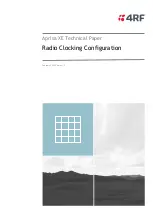
34 | About the Radio
Aprisa SR+ User Manual 1.11.1
Data Link Layer / MAC layer
The Aprisa SR+ PHY enables multiple users to be able to share a single wireless channel; however, a DLL is
required to manage data transport. The two key components to the DLL are channel access and hop by hop
transmission.
Channel Access
The Aprisa SR+ radio has two modes of channel access, Access Request and Listen Before Send.
Option
Function
Access Request
Channel access scheme where the base stations controls the
communication on the channel. Remotes ask for access to the
channel, and the base station grants access if the channel is not
occupied.
Listen Before Send
Channel access scheme where network elements listen to ensure
the channel is clear, before trying to access the channel.
Access Request
This scheme is particularly suited to digital SCADA systems where all data flows through the base station.
In this case it is important that the base station has contention-free access as it is involved in every
transaction. The channel access scheme assigns the base station as the channel access arbitrator and
therefore inherently it has contention-free access to the channel. This means that there is no possibility of
contention on data originating from the base station. As all data flows to or from the base station, this
significantly improves the robustness of the system.
All data messages are controlled via the AG (access grant) control message and therefore there is no
possibility of contention on the actual end user data. If a remote radio accesses the channel, the only
contention risk is on the AR (access request) control message. These control messages are designed to be
as short as possible and therefore the risk of collision of these control messages is significantly reduced.
Should collisions occur these are resolved using a random back off and retry mechanism.
As the base station controls all data transactions multiple applications can be effectively handled, including
a mixture of polling and report by exception.
Access Request
–
Full Duplex
This scheme is used in a network with a full duplex base station and half duplex repeater / remote radios.
Full duplex Access Request utilizes the existing (half duplex) Access Request scheme as described in the
section above.
The base station can transmit while simultaneously receiving from the remote / repeaters. This increases
Access Request efficiency, especially in the report by exception scheme (spontaneous messages).
This feature can be operated on full duplex hardware only (see ‘
If the Access Scheme is set to full duplex on a repeater, packets start to egress a repeater before the entire
packet has been received by the repeater. This scheme reduces latency on long packets through a repeater
and improves performance in Overlapping Coverage mode.
When the Access Scheme is set to full duplex on a repeater, it is mandatory to configure the Repeater
Network Segment IDs correctly (see ‘
Summary of Contents for Aprisa SR+
Page 1: ...January 2021 Version 1 11 1b ...
Page 2: ......
Page 10: ......
Page 72: ......
Page 86: ......
















































